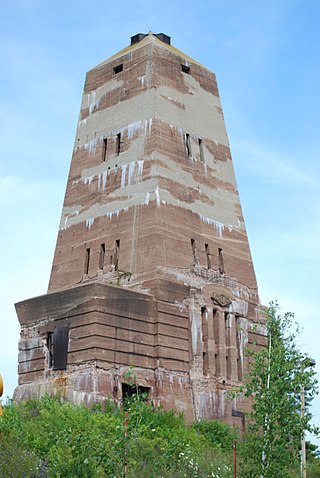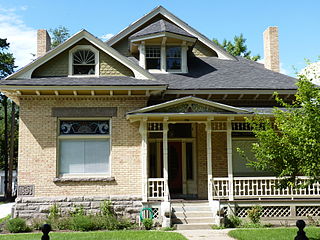
Malakoff Diggins State Historic Park is a state park unit preserving the largest hydraulic mining site in California, United States. The mine was one of several hydraulic mining sites at the center of the 1882 landmark case Woodruff v. North Bloomfield Mining and Gravel Company. The mine pit and several Gold Rush-era buildings are listed on the National Register of Historic Places as the Malakoff Diggins-North Bloomfield Historic District. The "canyon" is 7,000 feet (2,100 m) long, as much as 3,000 feet (910 m) wide, and nearly 600 feet (180 m) deep in places. Visitors can see huge cliffs carved by mighty streams of water, results of the mining technique of washing away entire mountains of gravel to wash out the gold. The park is a 26-mile (42 km) drive north-east of Nevada City, California, in the Gold Rush country. The 3,143-acre (1,272 ha) park was established in 1965.

Voyageurs National Park is an American national park in northern Minnesota near the city of International Falls established in 1975. The park's name commemorates the voyageurs—French-Canadian fur traders who were the first European settlers to frequently travel through the area. Notable for its outstanding water resources, the park is popular with canoeists, kayakers, other boaters, and fishermen. The Kabetogama Peninsula, which lies entirely within the park and makes up most of its land area, is accessible only by boat. To the east of the park lies the Boundary Waters Canoe Area Wilderness.

Lake Vermilion is a shallow freshwater lake in northeastern Minnesota, United States. The Ojibwe originally called the lake Onamanii-zaaga'iganiing, which means “the evening sun tinting the water a reddish color”. French fur traders translated this to the Latin word Vermilion, which is a red pigment. Lake Vermilion is located between the towns of Tower on the east and Cook on the west, in the heart of Minnesota's Arrowhead Region at Vermilion Iron Range. The area was mined from the late 19th century until the 1960s, and the Soudan Mine operated just south of the lake.

The Lake Vermilion-Soudan Underground Mine State Park is a Minnesota state park at the site of the Soudan Underground Mine, on the south shore of Lake Vermilion, in the Vermilion Range (Minnesota). The mine is known as Minnesota's oldest, deepest, and richest iron mine, and now hosts the Soudan Underground Laboratory. As the Soudan Iron Mine, it has been designated a U.S. National Historic Landmark.

The Cliffs Shaft Mine Museum is a former iron mine, now a heritage museum, located on Euclid Street between Lakeshore Drive and Spruce Street in Ishpeming, Michigan. The museum, operated by "Marquette Range Iron Mining Heritage Theme Park Inc.", celebrates the history of the Marquette Iron Range. The site was designated a state of Michigan historic site in 1973 and placed on the National Register of Historic Places in 1992.

Mogollon, also called the Mogollon Historic District, is a former mining town located in the Mogollon Mountains in Catron County, New Mexico, United States. Located east of Glenwood and Alma, it was founded in the 1880s at the bottom of Silver Creek Canyon to support the gold and silver mines in the surrounding mountains. The "Little Fannie" mine became the most important employer for the town. During the 1890s, Mogollon had a transient population of between 3,000 and 6,000 miners. Because of its isolation, it had a reputation as one of the wildest mining towns in the West. Today Mogollon is listed as Fannie Hill Mill and Company Town Historic District on the National Register of Historic Places.
Soudan is an unincorporated community and census-designated place (CDP) in Breitung Township, Saint Louis County, Minnesota, United States. As of the 2010 census, its population was 446.

The Minnesota Boat Club Boathouse on Raspberry Island is a historic structure in Saint Paul, Minnesota, United States. It is the home of the Minnesota Boat Club, a rowing club founded in 1870, that is Minnesota's oldest athletic organization. In 1885, a wooden structure was built on Raspberry Island to house the Minnesota Boat Club. The club constructed a new boathouse in 1910, which was designed by George H. Carsley in the style of Mission Revival architecture. The boathouse building was listed on the National Register of Historic Places in 1982.

North Manitou Island Lifesaving Station, also known as North Manitou Coast Guard Station, is a complex of buildings located on North Manitou Island, which is part of Sleeping Bear Dunes National Lakeshore in Michigan, in the U.S. The complex was constructed as a life-saving station. It is the only remaining station which was in use during all three periods of lifesaving service history, from the early volunteer period through operation by the United States Life-Saving Service and the United States Coast Guard. It was declared a National Historic Landmark in 1998.

The Mines of Spain State Recreation Area and E. B. Lyons Nature Center is a state park in Dubuque County, Iowa, United States. It is near Dubuque, the eleventh-largest city in the state. The park features picnic areas, 15 miles (24 km) of walking/hiking trails, 4 miles (6.4 km) of ski trails, and the Betty Hauptli Bird and Butterfly Garden. It also includes archaeological sites of national importance as an early lead mining and smelting venture led by French explorer Julien Dubuque, as well as Dubuque's gravesite. These sites were collectively designated a National Historic Landmark District as Julien Dubuque's Mines.

The Calumet Historic District is a National Historic Landmark District that encompasses most of the village of Calumet, Michigan. The district was designated in 1989 for the community's importance in the history of the region's copper mining industry.

Cama Beach State Park is a public recreation area facing Saratoga Passage on the southwest shore of Camano Island in Island County, Washington. The state park preserves the site of a renovated, modernized 1930s-era auto court and fishing resort.

The Johns Hotel (20IR64) is a complex of buildings, of which but two remain, located near Washington Harbor, on Barnum Island, Isle Royale National Park, Michigan. It was listed on the National Register of Historic Places in 1997.

The Charles E. Loose House is a historic house located in Provo, Utah, United States. The house was individually nominated for listing on the National Register of Historic Places in 1982 but was not listed due to owner objection. It later was included as a contributing property in the Provo East Central Historic District.

Libby's No. 23 is a historic sail-powered fishing vessel, now on display at the Lake Clark National Park and Preserve visitors center in Port Alsworth, Alaska. Built in 1914, she served in the salmon fishery of Bristol Bay until about 1951, owned by the Libby's cannery and worked by two-man crews. She is 29 feet 6 inches (8.99 m) long, with a beam of 9 feet 2 inches (2.79 m) and a depth of 4 feet (1.2 m). Its bow and stern are roughly the same shape, giving the style its name. Despite its use for freight and recreation between 1953 and 1997, the boat has retained much of its original equipment, and was fully restored by the National Park Service between 1998 and 2005, acquiring replacement parts from similar boats and removing an added motor. It is normally rigged with a mainsail and spritsail, but these are only raised when the boat is taken out of its custom-built boathouse.

The Pioneer Mine was an underground iron mine in Ely, Minnesota, United States, in operation from 1889 to 1967. It is one of only two such mines on the Vermilion Range whose above-ground structures are still standing, the other being the Soudan Mine. The Pioneer Mine Buildings and "A" Headframe were listed on the National Register of Historic Places as a historic district in 1978 for their state-level significance in the themes of engineering and industry. They were nominated for being some of the last vestiges of a once-common mining technique on the Vermilion Range.
The Adolph Levin Cottage is a historic vacation property on Kabetogama Lake in St. Louis County, Minnesota, United States. It contains a log cabin built in 1937 for two friends, Dr. Adolph Levin and George Plager. A metal water tank and the surrounding landscape are also contributing historic features. It is now preserved within Voyageurs National Park as an example of the early tourism and recreational properties in the area. In 2011 the property was listed on the National Register of Historic Places for its significance in the themes of architecture and entertainment/recreation. It was nominated for being a representative early-20th-century lake retreat, and for the rustic architecture and traditional Finnish construction of the cabin.

The Kabetogama Ranger Station District is a historic ranger station complex in Kabetogama, Minnesota, United States. It was built from 1933 to 1941 by the Civilian Conservation Corps (CCC) as an administrative center for Kabetogama State Forest, managed by the Minnesota Department of Natural Resources. Following the establishment of Voyageurs National Park in the 1970s, the Minnesota government finalized the donation of the property to the National Park Service (NPS) in 1987. The NPS continues to use the property as one of the four administrative and visitor entrances to Voyageurs.

The William Ingersoll Estate is a former summer home complex on an island in Sand Point Lake in the U.S. state of Minnesota, in what is now Voyageurs National Park. William P. Ingersoll (1885–1973) was a wealthy philanthropist from Canton, Illinois. He purchased the island property in 1927, when the Boundary Waters region had become a wilderness vacation destination for adventurous upper-class Midwesterners. The following year he installed a mail-order cabin from the E. F. Hodgson Company of Massachusetts, which specialized in prefabricated buildings. Ingersoll usually spent four months of the year on his island and continued to develop the property until he sold it in 1962 at the age of 77. In 2011 the estate was listed on the National Register of Historic Places for its local significance in the themes of architecture and entertainment/recreation. It was nominated as an example of the area's upper-class summer homes and as a rare intact example of a E. F. Hodgson Company kit house.

The Minong Traditional Cultural Property is a Traditional Cultural Property (TCP), which was listed on the National Register of Historic Places in 2019. Minong is the Ojibwe name for Isle Royale, and the TCP designation recognizes the lasting relationship the Grand Portage Band of Lake Superior Chippewa has with the island. The TCP covers the island itself, the greater archipelago, and the traditional fishing waters surrounding the islands.























